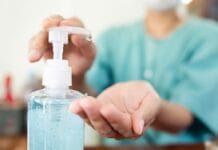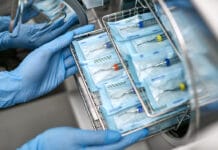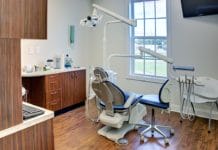Infection control: a topic we all love dearly (sarcastic cough). Let’s admit it; it’s a dry topic that not a lot of us enjoy. Let’s break it down. There are several very basic habits in day-to-day practice that I have noticed can have a big impact on patient care. Implementing some very simple steps will help ensure that you are providing the best care for your patients, following the appropriate CDC guidelines, and protecting your career. So let’s dig in:
Safety glasses for patients
Is providing safety glasses for your patients a practice you already do? I did for a long time at the first practice I was at; it was just a regular practice that we all adhered to in the office. When I began teaching dental hygiene, it was definitely required. However, when I returned to clinical practice, not many of my coworkers were providing safety glasses to all patients, so I got a little lazy and didn’t do it as often.
Then I came across something called Jenn’s Vision1. Here is a quote from her Facebook page, “July 8, 2013, Jenn became blind in her right eye after proper infection control procedures were not followed at the Dentist, a needle was dropped in her eye.” Doesn’t that just make you SICK! Immediately after I read about Jenn’s story, I re-implemented having my patients wear safety glasses.
Shortly thereafter, I was showing a pediatric patient the sealant procedure. When I do this, I squirt a little bit of etch, then adhesive, then sealant, on my finger to demonstrate all of the steps. As I was doing this, the tip of my etch tube popped off, and a large glob of etch dropped directly on her safety glasses. Imagine the consequences if I had NOT had her wearing them! This situation has become engraved in my brain and having patients don safety glasses is one of the first things I have my patients do. Of course, about 20% of patients decline to wear them. I then share Jenn’s story, and most of them comply. If they still don’t comply, I have them close their eyes.
Dealing with the issue of pre-set trays
We all know how time-consuming setting up an operatory can be, especially for the dental assistant. So often, the operatory is completely set up; sterile instruments are opened and lined up, prior to the patient entering the room. I scoured the Guidelines for Infection Control in Dental Health Care Settings, and couldn’t find a statement saying that the instruments must be opened in front of the patient2. I know it has been stated in Infection Control CE courses, however.
Think about it this way, I know when I go to have a PAP smear (sorry for being graphic!), I take comfort in seeing the doctor open that sterile package in front of me. If opening that sterile package in front of the patient isn’t possible (which for most of us hygienists, it should be), at the very least cover the instruments with a patient napkin. And there is no reason those instruments should sit overnight, open, uncovered, for who-knows-what to land on them. Take the extra five minutes in the morning to do the best for your patient. Do unto others as you would have them do unto you.
Order of donning PPE
What order do you don your personal protective equipment? Have you given it much thought lately? Back in dental assisting and hygiene school, this was a very important practice with a strict checklist that needed to be followed. First, wash/disinfect hands, putting on your mask, glasses, and finally, gloves. So often in clinical practice, I have seen clinicians (not going to point fingers at which title they hold) walk into an operatory, NOT disinfect their hands, put on their gloves, then their mask, and then don their loupes/safety glasses. Imagine what is on those glasses! They are used patient after patient and exposed to all of the aerosols and debris that are produced during our treatment.
First off, they NEED to be disinfected more often. Secondly, they should be one of the first things we put on. My suggestion is to walk in an operatory, greet patient, disinfect hands, put on a mask, safety glasses, and then gloves (I even throw in another hand sanitizer disinfection after donning my mask and glasses, prior to putting gloves on). Again, do unto others as you would have them do unto you. Would you want the debris and bacteria that is on your glasses, in your own mouth? I doubt it.
Purging water lines
This entire article could be written on waterline safety. That’s not my aim at this point, however. The main point I want to encourage you with is to FLUSH YOUR WATERLINES. Think of the water that has been sitting in those lines all night. Imagine all the fuzzy, squirmy bacterium that are having a party in those lines. Then think of your first patient. Lovely, 80-year-old Betty who has several medical conditions. Think of all those nasty bacteria that you will be squirting in her mouth with that first rinse.
At a recent Infection Control CE I attended, the speaker encouraged us to squirt that first squirt in our own mouths every morning. EW! If you wouldn’t do it to yourself, don’t do it to Betty. You don’t want to be the next headline. Do I have to say it again? Do unto others as you would have them do unto you.
Single wipe vs. double wipe?
Have you ever wondered if you really need to double-wipe? It is so easy in hectic, day-to-day clinical practice, to look for ways to cut corners and save a few minutes. One area of debate is whether it is truly necessary to double wipe to disinfect your operatory. Various surface disinfectant manufacturers claim their products are single wipe, for both cleaning and disinfecting. I and many other clinicians I know, have had the urge to only single wipe, especially since the product packaging says you can.
Maybe you think I will double wipe when my operatory is “really” dirty/bloody, or when certain patients with “really bad” medical conditions listed on their medical histories, then you will double wipe. It is so important to remember to use Standard Precautions! According to the CDC, “Standard Precautions are the minimum infection prevention practices that apply to all patient care, regardless of suspected or confirmed infection status of the patient3” (my emphasis added). You do not know, and many patients do not even know, the actual medical conditions they may have.
Treat everyone the same; the patient with HIV, Hep B, etc. According to the CDC’s Summary of Infection Prevention Practices in Dental Settings, “Clinical contact surfaces should be barrier protected or cleaned and disinfected between patients3” (my emphasis added). Did you catch that? First, you clean surfaces (first wipe), then you disinfect surfaces (second wipe). This is protocol is called wipe, discard, wipe; where two wipes are used. Yes, it takes a few more seconds, but do unto others as you would have them do unto you. Do you want your medical office cutting corners just to save a few seconds of time? No. Let’s do the best for our patients and go to sleep well every night, knowing that we did our absolute BEST.
Well, you made it! Infection control is not always a fun topic, but it is such an important one! I hope you are encouraged to do your very best for your dear patients. Happy scaling!
SEE ALSO: 5 Infection Control Mistakes You Might Not Realize You’re Making
DON’T MISS: Why Hygienists Should NEVER Treat Patients with Active Oral Herpes
References
- Jenn’s Vision. Retrieved January 31, 2018, from https://www.facebook.com/JennsVision
- https://www.cdc.gov/mmwr/PDF/rr/rr5217.pdf
- Centers for Disease Control and Prevention. (2016, October). Summary of Infection Prevention Practices in Dental Settings: Basic Expectations for Safe Care. Atlanta, GA: Centers for Disease Control and Prevention, US Dept of Health and Human Services. Retrieved January 31, 2018, from https://www.cdc.gov/oralhealth/infectioncontrol/pdf/safe-care2.pdf
















